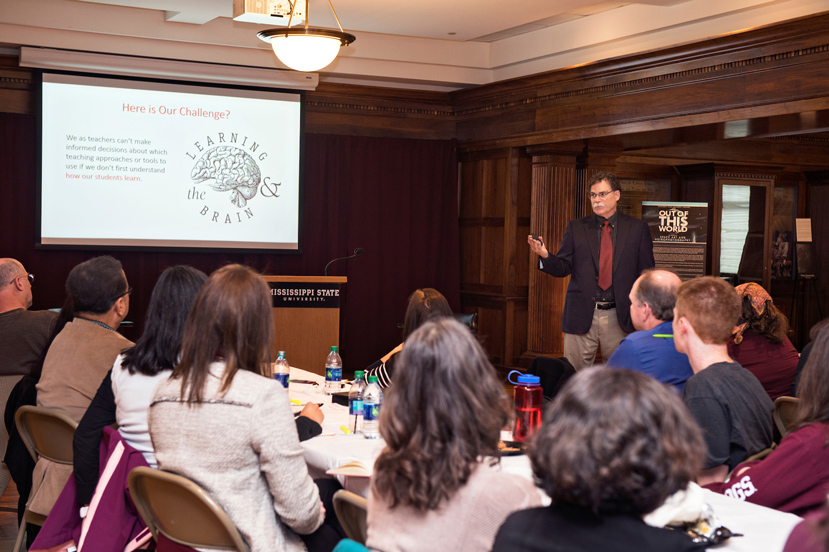MSU Maroon & Write guest speaker encourages learner-centered approach to teaching

Contact: Sasha Steinberg
STARKVILLE, Miss.— “The purpose of coming to Mississippi State is to leave as a lifetime learner,” nationally recognized educational consultant Terry Doyle said during a Friday [Feb. 3] afternoon presentation in the John Grisham Room at MSU’s Mitchell Memorial Library.
Sponsored by MSU’s Maroon & Write Quality Enhancement Plan and the Center for Teaching and Learning, Doyle’s presentation highlighted new research findings and ways to apply them in a higher education setting.
“Ultimately, our goal is to teach students how to learn by equipping them with the skills—oral and written communication, critical thinking and problem solving—they need to move forward in their education,” said Doyle, an author and professor emeritus at Ferris State University in Michigan.
To optimize student learning, Doyle said teachers must first understand the ways in which students take in, process and retrieve information. Enabling students to apply information they are learning in class is vital, he added.
“The bottom line is that students need to have use for the information they are learning when they want it, and they also have to be able to transfer that information,” Doyle said. “Learning is not about passing the test; it is actually being able to use information in meaningful ways.”
Doyle said students greatly benefit from teachers’ examples, metaphors, analogies and stories, but they often learn best when they are put in situations where they have to think and do for themselves.
“It’s one who does the work who does the learning,” Doyle said. “The best use of our expertise as teachers is to point ourselves at the most challenging and difficult parts of our courses and let our students do on their own what they can handle for themselves.”
According to Doyle, current research suggests that movement can play a powerful role in enhancing brain activity. In speaking from personal teaching experience, he said participation in walking discussion groups can help improve students’ ability to learn.
“At Ferris State, I would give my students questions to answer, have them go walk around campus for 20 minutes, answer the questions, and come back to class,” he said. “They always came back with all of the questions answered, but (more importantly) they came back more energized, engaged and alert.”
Because attention drives learning, Doyle said it is important for teachers to devise assignments and activities that cater to students’ visual, auditory and kinesthetic learning styles.
“Research tells us that the more senses you can get students to use in learning, the greater the likelihood they will make connections to what you’re talking about and be able to remember what you want them to remember,” he said.
“Every single thing the human brain does involves patterns,” Doyle added. “When you take content and teach it using a pattern that students are familiar with, you help build connections and understanding.”
Recent research findings also emphasize the importance of giving the brain plenty of downtime between learning experiences, a concept Doyle referred to as “spaced learning.”
“Memory is all about consolidation, and when we have new information coming immediately upon us, it disrupts that whole mental process and destroys the consolidation,” he said. “When the brain learns something new, it needs an extended period of time to process new information using the same mental process that was engaged in class.”
Doyle also noted that spaced learning can be just as helpful in class as outside of it.
“(There are) some models (that suggest) teaching for 20 minutes, taking 10 minutes off, teaching another 20 minutes and taking another 10 minutes off,” he said. “Early studies have shown that students actually learn more than they did if you were just lecturing or working the whole time because it gives the brain time to consolidate information.”
More than anything, Doyle said teachers can have a lasting impact on students by showing a genuine interest in them as people.
“You really have to take to heart how valuable it is for you to take your time to talk, connect with and encourage your students,” Doyle told teachers in the audience. “It’s amazing how powerfully you can influence their lives.”
“Maroon & Write,” the university’s quality enhancement plan—QEP, for short—focuses on improving undergraduate writing and learning skills across all colleges, curricula and class levels. The QEP is required to maintain accreditation with the Southern Association of Colleges and Schools.
Learn more about MSU’s Maroon and Write QEP at www.qep.msstate.edu or follow on Facebook @QEPMSU and Twitter @MSUQEP; Center for Teaching and Learning at www.ctl.msstate.edu or Facebook @msuctl and Twitter @MSU_CTL.
MSU is Mississippi’s leading university, available online at www.msstate.edu.